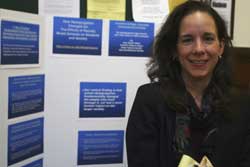Amy Stuart Wells Looks at How Desegregation Changed Us
Fifty years after Brown v. Board of Education, a groundbreaking study of hundreds of graduates from the Class of 1980 who attended racially mixed high schools at the height of school desegregation, as well as educators, officials and activists associated with these schools, indicates that these students greatly benefited from their interactions with members of other races in school. Many believed that desegregation signified a major step toward a more equitable society, helped them overcome racial stereotypes, and created a greater sense of comfort and togetherness across color lines.
At the same time, the study reveals that desegregated schools were often segregated across classrooms, that students were discouraged from talking about race or desegregation in school, and that cross-racial friendships were important, but often only went so far, as students returned to segregated neighborhoods after school.
These are among the findings of How Desegregation Changed Us: The Effects of Racially Mixed Schools on Students and Society, prepared by Amy Stuart Wells, Professor of Sociology and Education, and scholars at the University of California at Los Angeles. The study is the first ever to look at the significance of school desegregation from the perspective of the students who lived through it.
Now in their early 40s, these graduates of desegregated schools struggle to find quality, mixed-race schools for their own children because in the years since they graduated from their diverse public schools, political leaders have increased their focus on narrow measures of accountability and high-stakes tests while losing their focus on fostering equal educational opportunities and better race relations, the study claims.
"Today there's a much greater emphasis on test scores than there was 25 years ago and much less emphasis on schools as places where people learn different points of view and the complexity of our diverse society," says the report. "Ironically, that is what these graduates found to be most valuable about their education once they became adults."
Despite the graduates' positive experiences in desegregated schools, many graduates now feel pressured to get their children into the schools with the highest test scores, and for white parents, this often translates into a choice of less diverse schools. About half of the white graduates interviewed who had school-age children enrolled them in racially diverse schools, compared to about 75 percent of the African-American and Latino graduates with school-age children. Still, many of the graduates-of all racial backgrounds-with children in racially diverse schools reported that these schools were becoming less diverse over time as desegregation plans were dismantled or white flight occurred.
"Our data and analysis demonstrate that racially mixed public schools of the late 1970s were doing more than most institutions in our society-except perhaps the military-to bring people of different racial/ethnic backgrounds together and foster equal opportunity," notes Wells. "But our study also found that when these students graduated, the changing political priorities of the 1980s and 1990s overwhelmed efforts to continue progress toward a more integrated society. These graduates became part of a society that had not changed as much as their schools had-a society that has remained segregated, especially in terms of housing and now increasingly in terms of schools for their children."
The study recommended that policies and reform movements support the creation and maintenance of racially diverse schools. This could be accomplished by including racial diversity to indicators of accountability as a measure of a "good" public school; amending current public school choice policies to make them supportive of racial diversity in schools; and looking at the non-education issues, such as housing, that affect diversity in public schools.
Published Monday, Jan. 10, 2005
